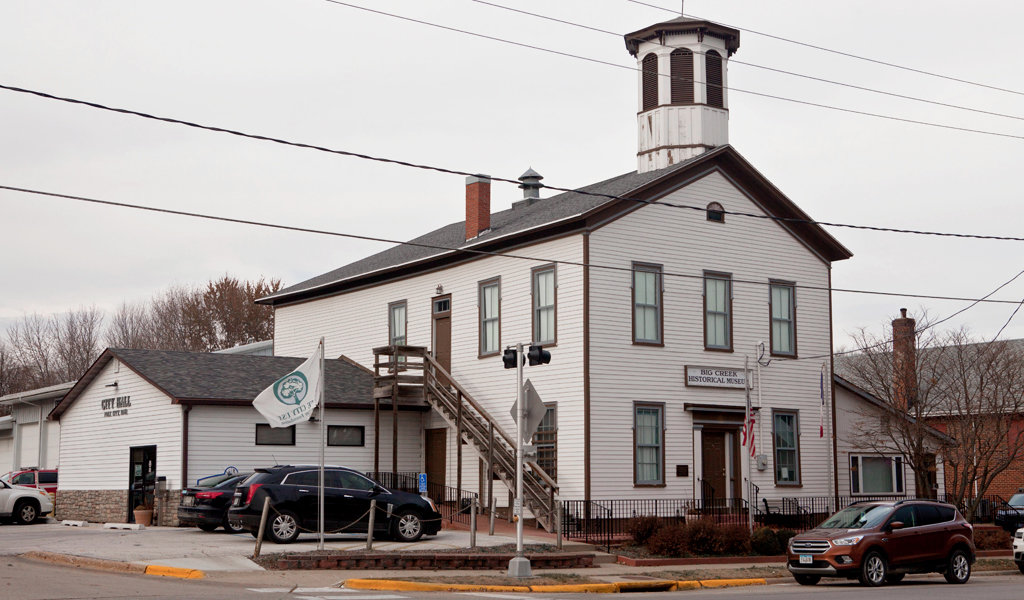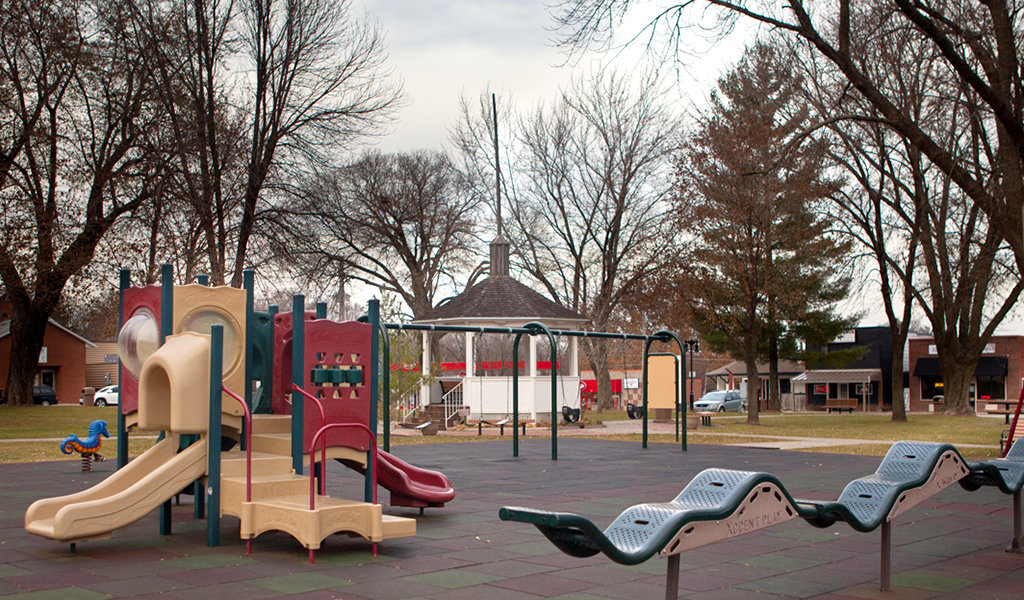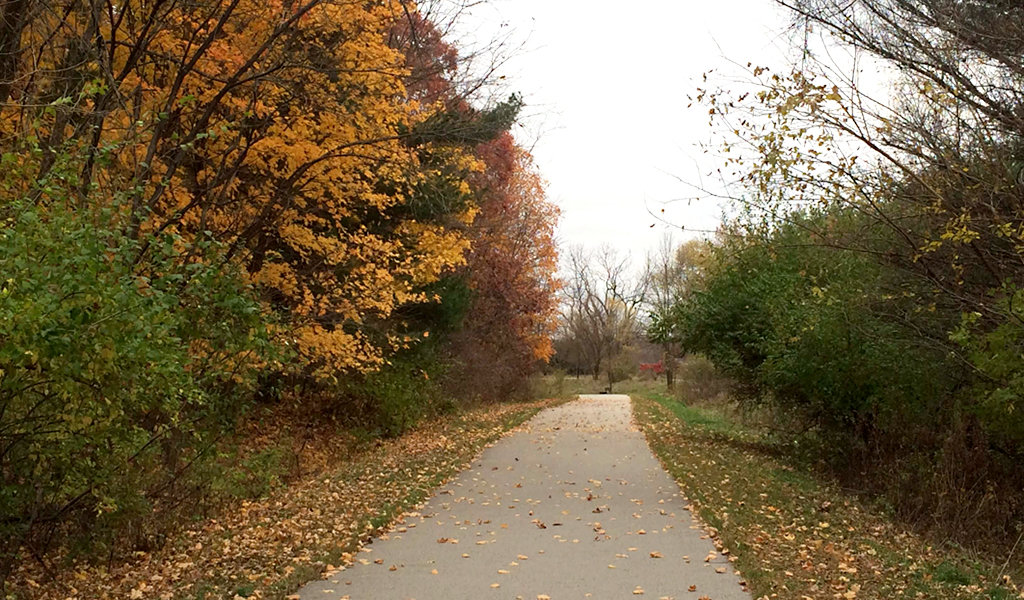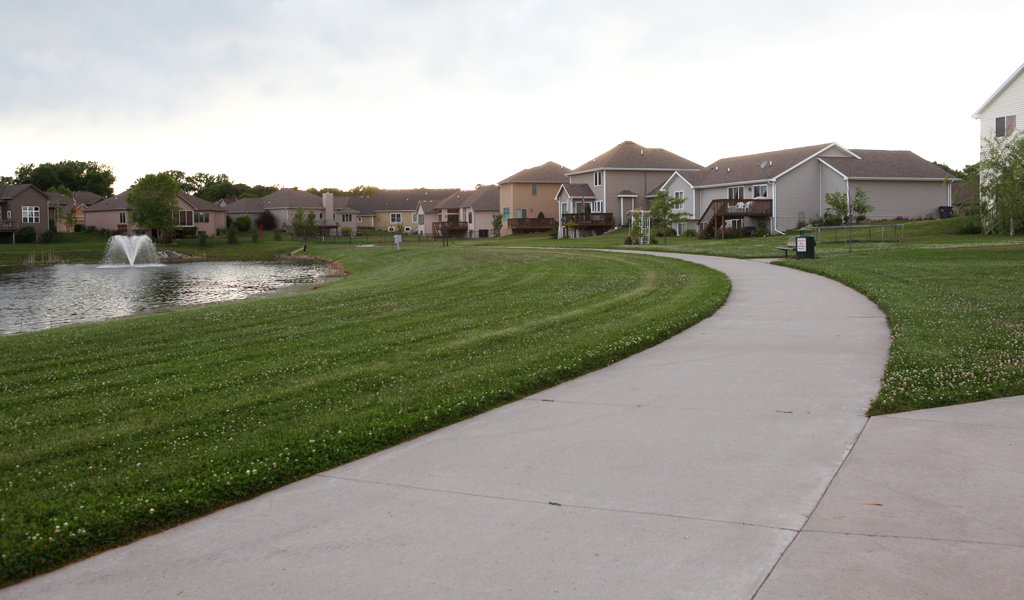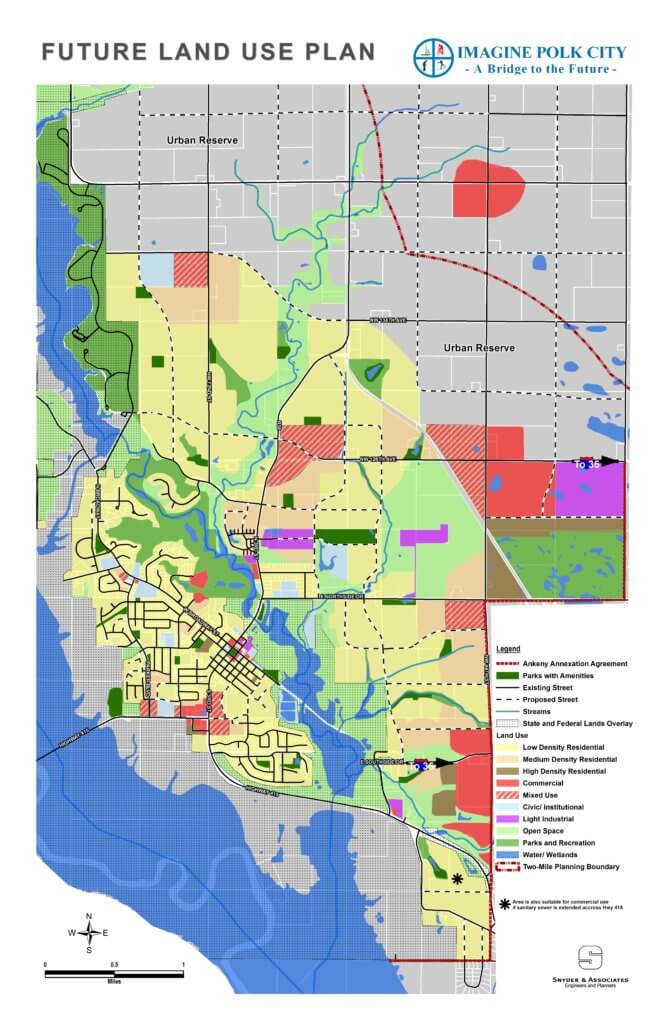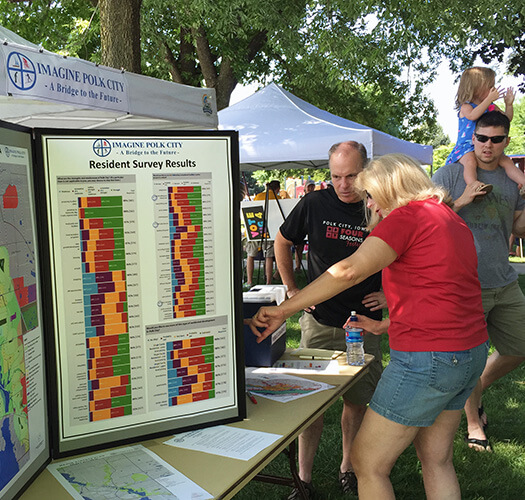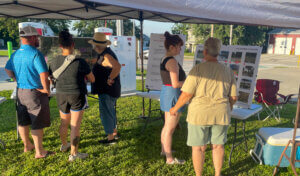
Growing Community Requires Strategic Comprehensive Plan
Located approximately 16 miles northwest of downtown Des Moines, Polk City is primarily a residential community. Its convenient location is ideal for those seeking the tranquility of small-town life, with a short commute to the larger metro area. Likewise, Polk City’s close proximity to regional recreational amenities like Big Creek State Park, Saylorville Lake, and the Central Iowa trail system make it the perfect community for those with a love for the outdoors.
Polk City has been experiencing rapid growth over the past 20 years. From 1990 to 2010, Polk City’s population increased by 79 percent. A Single Family Active Subdivision (SFAS) study completed in 2014 indicated that approximately 535 additional lots would be platted for construction by 2018. Increased growth had residents and officials concerned about maintaining the small-town character while addressing growing housing, environmental, and transportation needs.
With the increase in housing demand and rapid growth issues, a comprehensive plan study completed in 2002 was soon out of date. Snyder & Associates was enlisted in 2014 to investigate the current trends and create a new comprehensive plan to guide the community going forward.
Comprehensive Plan Provides a Road Map for the Future
A comprehensive plan is a long‐range policy guide for making decisions about the physical development of a community. A plan doesn’t, however, provide a detailed solution for the development of specific sites. Instead, it sets out broad policy directions for growth, development, and redevelopment.
A successful comprehensive plan represents the community’s vision for the future and is therefore heavily dependent upon public participation. Residents, business leaders, and city staff work together to identify the issues and challenges that are facing the community, along with the assets and opportunities that can be better utilized.
These assembled groups then collaborate on developing a vision of the community, followed by a plan of action to achieve that vision. The plan created for Polk City analyzed and incorporated a wide variety of components, including the natural environment, population, current and future land use, transportation, parks and trails, infrastructure, public facilities and services, and growth management.
Since a comprehensive plan is a guidance document, its recommendations must be implemented in order to be effective. This happens through the policies, programs, and ordinances established by community leaders. The comprehensive plan created for Polk City incorporated an implementation strategy that will help city officials and staff to effectively execute the goals outlined in the plan.
Iowa Smart Planning Principles Considered in Creation of Comprehensive Plan
The Snyder & Associates planning team was guided by the Iowa Smart Planning Principles throughout the entirety of the study. These principles were implemented to ensure that planners consider and apply specific ideas during the planning process. These principles include:
- Collaboration
- Efficiency, transparency, and consistency
- Clean, renewable, and efficient energy
- Occupational diversity
- Revitalization
- Housing diversity
- Community character
- Natural resources and agricultural protection
- Sustainable design
- Transportation diversity
Guided by these principles, the planning team completed the entire project, which included project management, leading the planning process, researching demographic data, developing population projections, drafting text, writing and executing public opinion surveys, and creating existing and future condition maps using GIS. The team used the information gathered throughout the planning process to determine which objectives met the needs of Polk City.
Public Engagement Strategies Critical for Understanding Issues
Snyder & Associates facilitated public engagement throughout the study period using multiple methods. The Polk City Planning & Zoning Commission served as the project’s Steering Committee for the project. They reviewed all components, including maps of existing conditions, concept plans for transportation, parks and trails, land use, and infrastructure.
The Stakeholder Committee consisted of people who represented various public and private groups. This committee assisted with the identification of issues, strengths, constraints, opportunities, goals, and objectives. The Snyder & Associates planning team conducted one-on-one interviews with dozens of people who had specific ideas and concerns related to the library, police, public works, and other governmental agencies.
The planning team gathered helpful insight into the community’s values and preferences through a business survey that garnered 21 responses. A survey of the town’s residents was distributed through email, social media, and on the city’s website. The residential survey gathered an additional 389 returns. A public open house allowed residents to view the results of the plan, ask questions, and provide additional comments about the plan’s objectives.
Our team also set up an informational booth at the Four Seasons Festival, a local community celebration. The booth included six display boards showing maps, survey results, and comment sections. This allowed residents who might not have been able to attend a meeting or open house to learn more about the comprehensive plan.
Core Areas of Concern Determined During Planning Process
The initial planning process revealed that quality of life issues should be a highlight of the plan. This includes identifying new approaches for parkland dedication and development. Snyder & Associates completed a Level of Service (LOS) analysis using the 2015 National Recreation and Park Association’s (NRPA) system which collects and analyzes data about parks and recreation agencies. This tool allows communities to compare their park and related services to other communities’ services that are similar in size.
With 665 people per square mile, Polk City can be compared to other agencies having between 500 and 1,500 people per square mile. According to the NRPA report, the median number of acres per 1,000 population is 12.1 acres. Polk City provides close to the median with 10.85 acres per 1,000 people, leaving room for improvement. To increase the LOS, the plan made the following recommendations:
- Develop a five year Capital Improvement Program (CIP) for parks and establish annual budgets.
- Prioritize the development of new parks near residential development.
- Modify parkland dedication ordinance to require usable park grounds in terms of slope, access, and location.
- Complete trail connections to existing and future parks.
Adoption & Implementation of Comprehensive Plan Key to Creating Sustainable & Measurable Success
Polk City formally adopted the comprehensive plan in early 2016. The Snyder & Associates planning team gained support for the plan by engaging and educating the public throughout the entire process. Public meetings with residents and businesses created a sense of ownership within the community. Because of the overwhelming community acceptance of the plan’s vision, support for the plan’s implementation naturally followed.
The implementation schedule identified the type of improvement, timeframe, the performance measures, and the partnering organizations for each objective. To date, implementation is evidenced through these accomplishments:
- Several new subdivisions have been platted and additional land is being annexed to address the rapid growth compliant with the Future Land Use Plan.
- Additional commercial, mixed-use, and Planned Unit Development (PUD) districts have been identified. The development of these areas is in the planning stages.
- Parkland is being designated in new residential developments along with trail easements, creating cross-town and regional connections.
- The town square and small-town feel is being preserved with facility improvements, new businesses, and gathering spaces.
- Transportation issues are being addressed with the addition of turn lanes and signage at major intersections.
- Quality of life is being enriched with community festivals, concerts, farmers markets, and other events.
- Zoning and subdivision ordinances have been reviewed and enhanced.
Continued Sustainability of Comprehensive Plan’s Success
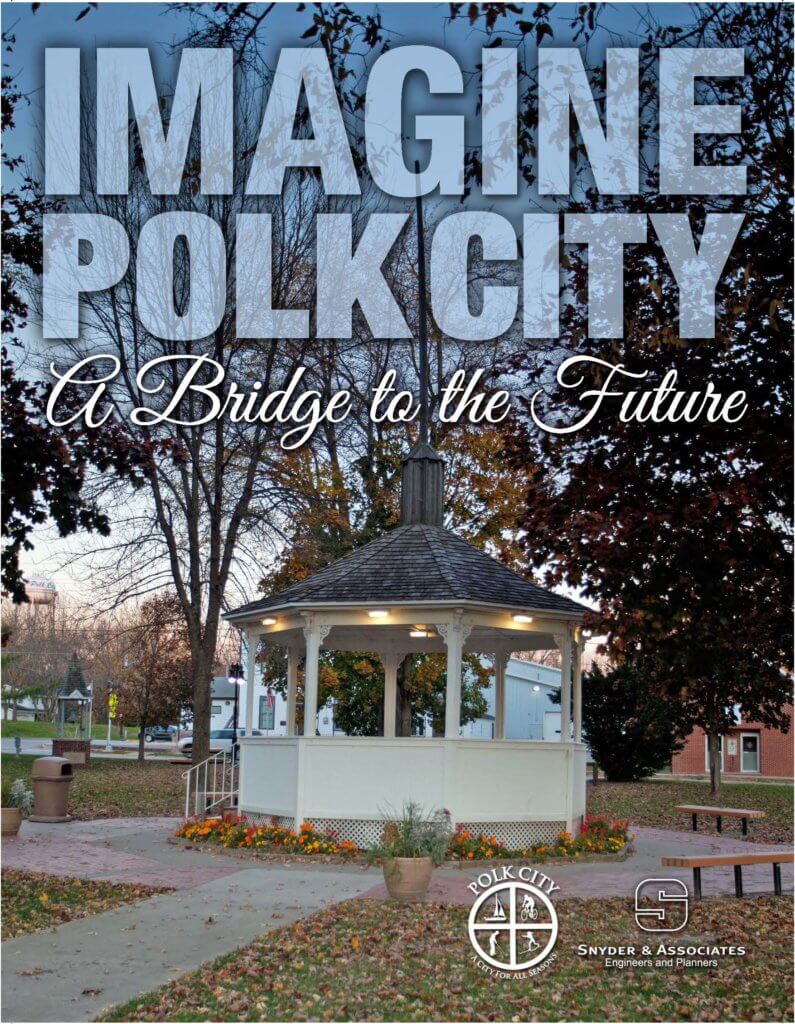 The new, Imagine Polk City: A Bridge to the Future comprehensive plan created a 20-year vision for the entire community. Polk City officials have expressed their commitment to implementing the goals of the plan with each decision they make. The plan aims to make a difference in the lives of residents by preserving the small-town atmosphere and high quality of life that originally attracted new residents to the community. By addressing transportation options, street cross-sections, architectural design, parkland dedication, and future commercial development, the city will build upon its existing strengths and minimize its weaknesses.
The new, Imagine Polk City: A Bridge to the Future comprehensive plan created a 20-year vision for the entire community. Polk City officials have expressed their commitment to implementing the goals of the plan with each decision they make. The plan aims to make a difference in the lives of residents by preserving the small-town atmosphere and high quality of life that originally attracted new residents to the community. By addressing transportation options, street cross-sections, architectural design, parkland dedication, and future commercial development, the city will build upon its existing strengths and minimize its weaknesses.
City staff and elected officials were impressed by how strongly residents felt about how this plan truly represents Polk City as a whole. This was attributed to the planning team listening to and engaging with so many stakeholders. The plan is trusted because of the valid and thorough process that planners used to develop it. Moving forward, this plan should be viewed as the lodestar of the community, pointing it in a thoughtful and consistent direction by providing valuable information for residents and developers.
